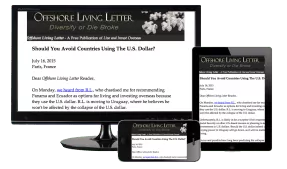
Why I Focus On Real Estate Price And Not Exchange Rate
I’m Buying Euros Today (And Maybe You Should Be, Too)
I don’t usually pay attention to exchange rates on a daily basis. However, being in Europe for the last month, I’ve been watching the U.S. dollar rate versus the euro.
The euro has dropped from US$1.13 to US$1.115 since I arrived about four weeks ago.
The difference of a penny-and-a-half—or a bit less than 1.5%—isn’t going to change anyone’s lifestyle day to day, but, if you’re considering a property purchase, 1.5% can start to look like real money.
While it’s impossible to time a real estate purchase based on currency values, if you’re in the market for a property in Europe, you could think about dollar cost averaging your euros and exchanging some dollars today, while the euro is at its weakest point since the summer of 2017.
I am.
My point is that the current dollar-euro rate is presenting an opportunity that you should act on if you have any euro intentions.
This is not the same thing as waiting for a currency to hit some personal ideal exchange rate before pulling the trigger on a property purchase.
That strategy can backfire on you in two ways.
First, who’s to say that the exchange rate will ever hit the arbitrary target? The rate you decide you want might never materialize.
Meantime, while you’re waiting for that exchange rate to strike, real estate values in the market where you’re looking to buy can be appreciating… so that, even if the exchange rate you’re waiting for comes to pass, you could end up paying more for your property in dollar terms.
Why I Found When I Bought Real Estate In Colombia
In 2011, I bought an apartment in Medellín, Colombia.
A reader wrote in at the time to tell me I was stupid to be buying property in Colombia at the then exchange rate of around 1,800 pesos to US$1. He was going to wait to buy until the exchange rate hit his target of 3,000 to the dollar.
More than four years later, the peso finally fell to 3,000 to US$1. However, property values in Medellin had risen 40% or more in the same time frame. If the guy who’d written in to chastise me was still looking at property in Medellín in 2015, when the exchange rate hit his target, he would have been able to buy a property for maybe 10% less in U.S. dollar terms than he could have in 2011.
And he’d missed out on four years of use and/or rental return.
For me, the exchange rate didn’t matter. I saw Medellín as a buy… a market I wanted in on. I found and purchased an apartment that we still own. In the eight years since, the value in peso terms has at least tripled. In U.S. dollar terms, it’s a double.
And, meantime, I have had use of the property all these years and could have had rental income.
In 2015, I bought an apartment in Lagos, Portugal. The euro-dollar exchange rate at the time was at a 12-year low. I didn’t buy the property because the euro was weak, but, rather, again, because this was a market I wanted in on and I’d found an undervalued property in a location I liked.
Today, that property is worth twice what I paid for it in euro terms.
When buying a piece of real estate in a foreign market, you’re making two investments.
You’re investing in the property, of course… but you’re also investing in the local currency. Wait for the price of one or the other to be where you decide you want it to be, and the other can go against you.
That’s why I focus on the real estate piece of the equation when making my purchase decisions.
Real estate is a long-term investment. Currencies go up and down every day over longer up-and-down cycles. Pick real estate markets where you want to own for the long haul and buy when prices are good.
This means buying in places where you plan on spending time… which brings me back to Europe.
I spend several months a year in the euro zone. While I have euro-based assets, the current income from those assets doesn’t cover my annual euro spending (well, it might cover mine, but it doesn’t cover my wife’s).
Therefore, I’m looking for more euro-based investments.
With the euro at a two-year low against the Greenback, moving some dollars into euros now in preparation for my next euro investment (or even stockpiling spending money) makes sense.
Could the euro drop further? Of course.
Does anyone know if or when that will happen? No.
In the history of the euro, it cost less than a U.S. dollar from January 2000 to mid-2002. I’d love to see that level again. What an opportunity that would present for stocking up on euros and euro-denominated investments.
However, wanting to see the euro worth less than a dollar is not the same as deciding I’m going to wait to make another euro investment until the euro is worth less than a dollar. That’d be foolish.
Instead, I’m sending extra dollars to Europe this week… and I have someone looking for farms for me in Portugal. With the dollar up 1.5%, I can consider slightly larger properties for purchase.
If you don’t have a bank account where you can store your euros, I recommend a moneycorp account. This would give you a short-term place to keep euros. And using moneycorp to make the exchange, you’ll get an excellent rate.
For holding euros longer term, you could look into an account with Barclay’s International in the U.K. They require a minimum account balance of 25,000 pounds.
However, more to the point, the last I spoke with them they were still opening accounts for Americans over the phone. The process takes about an hour.
Lief Simon



